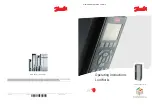
www.procontechnology.com.au
1 Phone: (03) 98306288
MEAN WELL DC-DC CONVERTER USER MANUAL
1. INPUT
1.1 INPUT VOLTAGE
DC to DC converters are widely used all over the world. Many types of products are available for both high and low DC voltage
input. Before using any DC-DC converter, ensure that the output voltage and current is suitable for the intended load. Verify the
correct input connections, particularly the polarity, and any other conditions that might affect the unit's operation.
If an input voltage is applied which is different from the converter's rating, the unit may be damaged. Also remember that if the
input voltage is not pure DC, the device may not operate normally. Only the Meanwell SD-100D and SD-150D, type D input
converters allow an AC input (85~132VAC).
For all Mean Well Models refer to the label on the converter for the input voltage range.
1.2 INPUT CURRENT
The essential difference between an AC to DC power supply and a DC to DC converter is not just that the DC-DC converter
generally uses lower input voltages but that it does not require rectification of AC to DC nor does it require AC power factor
correction circuitry. Standard DC to DC converters simply filter the Direct Current (DC) input which then charges a smoothing
or filtering capacitor. The input current required is determined by the output power, input voltage and efficiency. The simplest
input stage with reverse polarity fuse protection is shown below:
Fig. 2
Not all Meanwell DC-DC converters have reverse polarity input protection. The simplest form of protection is a fuse and a
diode; if necessary the user may provide these components externally. The latest Meanwell high-wattage DC-DC converters
(RSD and DDR series) use a MOSFET circuit that tolerates accidental polarity reversal without damaging the unit.
Also not all DC-DC converters have sufficient EMI (Electromagnetic Interference) filtering and may require external filtering
of the input to meet regulatory requirements. Please refer to the data sheet.
1.3 INRUSH CURRENT
When power is applied, a large current flows to charge the input smoothing or filter capacitor. This current is called the "inrush
current". The value of the inrush current varies according to the size of the smoothing capacitor and the presence or absence of
the inrush current protection devices. The inrush current is many times larger than the normal input current. The more DC-DC
converters used in the same system, the larger the inrush current. Please ensure that fuses, switches, and other parts connected to
the input supply side are appropriately selected. Also, when powering DC-DC converters from other DC sources you will need
to allow for this inrush current and make allowance for the switch-on sequence of multiple converters.
If the converter's fuse is blown, do not replace the fuse and operate the unit before rectifying the problem that caused it to fail –
otherwise further damage may occur! Always replace the fuse with the same rated type. Always remove power to the unit and
discharge the input smoothing capacitor before attempting to replace the fuse.































